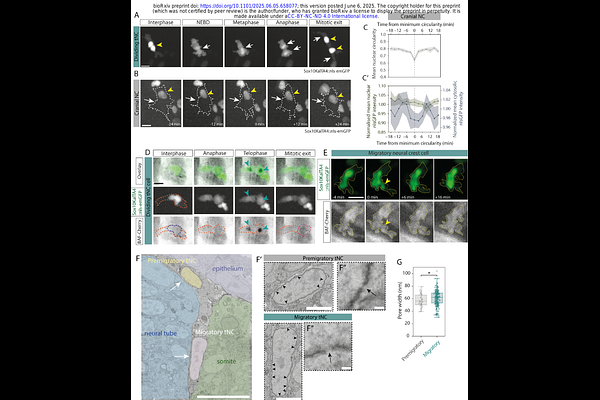In vivo nuclear envelope adaptation during cell migration across confining embryonic tissue environments

In vivo nuclear envelope adaptation during cell migration across confining embryonic tissue environments
Haekkinen, H.-M.; Villaseca, S.; Alhashem, Z.; Chomiczewski, S.; Desevedavy, M.; Leleux, S.; Hamidzadeh, A.; Gallo, F.; El-Zohiry, D.; Petre, V. G.; Scarpa, E.
AbstractIn physiology and in disease, cells often migrate through narrow spaces, such as leukocytes undergoing diapedesis or cancer cells during dissemination. Cultured cells under physical confinement have been shown to experience mechanical stress due to deformation of the nucleus. Nuclear deformation can lead to loss of nuclear integrity and DNA damage, and it has been proposed to underlie cancer initiation and progression. In vivo, the consequences of physical confinement on physiological, developmental cell migration remain so far unexplored. Here, we use the zebrafish neural crest as an in vivo model to address how multipotent embryonic cells respond to physical confinement during developmental migration. By measuring the extracellular space from head to tail along the embryonic body axis, we found that the level of tissue scale confinement increases along the antero-posterior axis. We found that neural crest experience dramatic nuclear deformation during their migrating between adjacent tissues, which quantitatively scales with tissue confinement. By using complementary genetic and mechanical strategies to ablate the surrounding tissue, we observe a rescue of nuclear deformation in vivo. Surprisingly, we found that while deformation of the NC nucleus causes stretching of the nuclear envelope, it does not cause DNA damage even upon extreme deformations. Instead, cells adapt, by decreasing both their DNA damage and LaminB2 levels upon entering confined spaces. In summary, we establish the neural crest as a physiological framework uncovering a dynamic adaptation to tissue confinement in vivo.